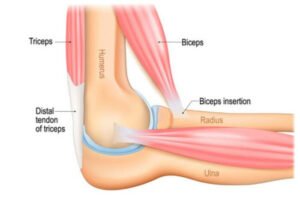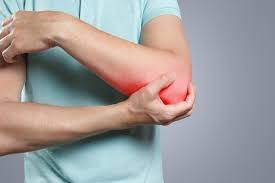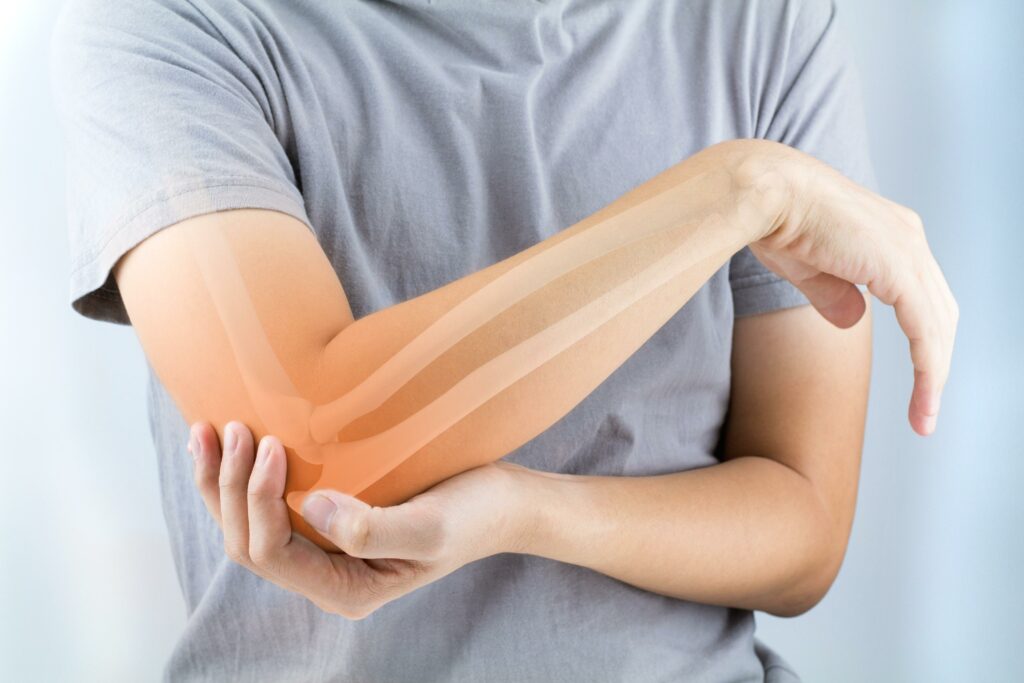Tennis elbow is a common condition that affects countless individuals worldwide. Despite its name, this condition doesn’t exclusively afflict tennis players. It can affect anyone who performs repetitive arm movements, especially those involving the forearm. In this article, we will delve into the causes of tennis elbow, its symptoms, treatment options, and effective prevention strategies to keep this bothersome condition at bay.
Contents
Understanding the Anatomy of the Elbow

The elbow is a complex joint that allows for the bending and straightening of the arm and also enables the forearm to rotate. It is composed of three bones, multiple ligaments, tendons, and muscles that work together to facilitate various movements. Let’s explore the anatomy of the elbow in more detail:
Bones:
- Humerus: The upper arm bone, which forms the main part of the elbow joint. The rounded end of the humerus, known as the capitulum, articulates with the radius, while the trochlea articulates with the ulna.
- Radius: One of the two forearm bones, located on the thumb side of the arm. It connects to the capitulum of the humerus to form the lateral (or outer) part of the elbow joint.
- Ulna: The other forearm bone, situated on the little finger side of the arm. It connects to the trochlea of the humerus and forms the medial (or inner) part of the elbow joint
What is Tennis Elbow?
Tennis elbow, medically known as lateral epicondylitis, is a condition characterized by the inflammation and microtears of the extensor tendons in the forearm, particularly the extensor carpi radialis brevis tendon.
Despite the name, tennis elbow can be caused by various activities beyond tennis, including repetitive motions like typing or using a screwdriver.
Risk Factors for Tennis Elbow

Tennis elbow, or lateral epicondylitis, is a condition that develops due to overuse and strain on the tendons in the forearm, causing pain and tenderness on the outer side of the elbow. Several risk factors can increase the likelihood of developing tennis elbow. These include:
- Repetitive Movements: Engaging in repetitive motions of the wrist and forearm, especially those involving forceful gripping and wrist extension, can strain the tendons and increase the risk of tennis elbow. This commonly occurs in activities like playing tennis, other racquet sports, manual labor, typing, and using hand tools.
- Age: Tennis elbow is most common in people between the ages of 30 and 50, though it can affect individuals of any age.
- Occupation: Certain occupations that involve repetitive wrist movements and forceful gripping are associated with a higher risk of tennis elbow. Jobs such as carpenters, plumbers, painters, butchers, and assembly line workers are more prone to developing the condition.
- Sports Participation: Participation in sports that require repetitive wrist and forearm movements, such as tennis, squash, golf, and weightlifting, can increase the risk of tennis elbow.
- Lack of Proper Technique: Poor technique in sports or physical activities can put excessive stress on the forearm tendons, making them more susceptible to injury.
Symptoms of Tennis Elbow
Tennis elbow, or lateral epicondylitis, is characterized by specific symptoms that primarily affect the outer side of the elbow. These symptoms may develop gradually and worsen over time. The main symptoms of tennis elbow include:
- Pain on the Outer Side of the Elbow: The most common symptom is pain and tenderness on the bony prominence of the outer side of the elbow, known as the lateral epicondyle. The pain may start as mild discomfort and gradually become more intense over weeks or months.
- Pain with Specific Movements: The pain is typically aggravated by certain movements of the wrist and forearm. Activities that involve gripping, lifting, or repetitive wrist extension (bending the wrist backward) can trigger or worsen the pain. For instance, shaking hands, holding a coffee cup, turning a doorknob, or using a screwdriver may become painful.
- Weakness in the Affected Arm: Tennis elbow can lead to weakness in the forearm and grip, making it challenging to perform tasks that require a firm grip or forearm strength.
- Stiffness: Some individuals with tennis elbow may experience stiffness in the elbow, especially after periods of rest or upon waking up in the morning.
Diagnosing Tennis Elbow
Diagnosing tennis elbow involves a combination of a thorough medical history, a physical examination, and, in some cases, imaging tests. A healthcare professional, such as an orthopedic doctor or a sports medicine specialist, will perform these assessments to confirm the diagnosis. Here’s what you can expect during the process of diagnosing tennis elbow:
- Medical History: The doctor will begin by asking you questions about your symptoms, when they started, and the activities or movements that seem to aggravate the pain. They may inquire about your occupation, sports participation, and any recent injuries or traumas to the elbow or forearm.
- Physical Examination: The doctor will conduct a physical examination of the affected elbow and forearm. During the exam, they will look for specific signs that are typical of tennis elbow, such as:
- Tenderness over the lateral epicondyle (the bony prominence on the outer side of the elbow).
- Pain with resisted wrist extension: The doctor will ask you to extend your wrist against resistance, which may elicit pain if you have a tennis elbow.
- Pain with gripping: Gripping an object, such as a tennis racket or a doorknob, may reproduce the pain.
Treatment of Tennis Elbow

The treatment of tennis elbow, or lateral epicondylitis, typically involves a combination of conservative measures to reduce pain, promote healing, and strengthen the forearm muscles.
In most cases, surgery is not necessary, and the condition can be effectively managed with non-surgical treatments. The following are common treatment approaches for tennis elbow:
- Rest: Avoid activities that exacerbate the pain and put a strain on the affected tendons. Rest allows the injured tendons to heal.
- Ice Therapy: Applying ice to the affected area can help reduce inflammation and alleviate pain. Use an ice pack or wrap ice in a thin cloth and apply it to the elbow for 15-20 minutes at a time, several times a day.
- Pain Relief Medications: Over-the-counter pain relievers or nonsteroidal anti-inflammatory drugs (NSAIDs) like ibuprofen or naproxen can help manage pain and reduce inflammation. Always follow the recommended dosage and consult a healthcare professional if you have any medical conditions or take other medications.
- Physical Therapy: A physical therapist can provide specific exercises to strengthen the forearm muscles, improve flexibility, and promote healing. Eccentric exercises, where you slowly release the grip or wrist extension, have shown to be particularly effective for tennis elbow.
- Forearm Braces or Straps: Wearing a brace or forearm strap just below the elbow can help relieve pressure on the affected tendons during activities and reduce pain.
- Extracorporeal Shock Wave Therapy (ESWT): In some cases, ESWT may be recommended. This non-invasive treatment uses shock waves to stimulate healing in the affected area.
- Corticosteroid Injections: If conservative treatments do not provide sufficient relief, a corticosteroid injection may be considered to reduce inflammation and alleviate pain. However, these injections are generally limited to one or two, as repeated injections can weaken the tendons and delay healing.
Living with Tennis Elbow
Living with tennis elbow, or lateral epicondylitis, can be challenging, but several strategies and lifestyle adjustments can help you manage the condition and minimize its impact on your daily life. Here are some tips for living with tennis elbow:
- Rest and Modify Activities: Give your affected arm time to heal by avoiding activities that worsen the pain or strain the forearm tendons. Modify your daily tasks and work activities to reduce repetitive wrist movements and gripping. If possible, use your unaffected arm for tasks that would put a strain on the injured elbow.
- Use Proper Technique: When engaging in physical activities or sports, use proper techniques and form to avoid putting unnecessary stress on the elbow. Ask for guidance from a coach or trainer if you participate in sports that involve repetitive wrist movements or gripping.
- Warm-Up and Stretch: Before any physical activity, warm up your forearm muscles and perform gentle stretches to improve flexibility and reduce the risk of injury.
- Apply Ice: When you experience increased pain or inflammation, apply ice to the affected area for 15-20 minutes several times a day to help reduce swelling and alleviate discomfort.
Conclusion
Tennis elbow is a prevalent condition that can affect people from all walks of life. Understanding the causes, symptoms, and treatment options is crucial for timely intervention and effective management. By adopting preventive measures, seeking appropriate medical care, and taking care of their overall health, individuals can minimize the impact of tennis elbow and maintain an active lifestyle.
If you’re experiencing Elbow pain, physical therapy for elbow pain at PhysioMantra can help: Book an online physical therapy session.



